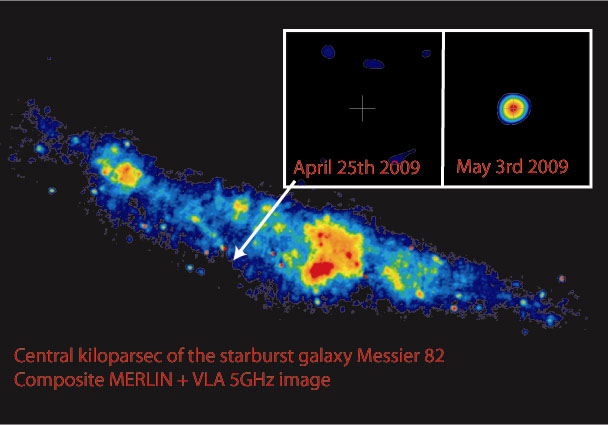
The object suddenly began pumping out radio waves last year in the relatively nearby galaxy M82, some 10 million light-years away. Its discovery was announced Tuesday.
"The new object, which appeared in May 2009, has left us scratching our heads - we've never seen anything quite like this before," said researcher Tom Muxlow, a radio astronomer at the University of Manchester's Jodrell Bank Observatory in England.
M82 is a "starburst galaxy," one that churns out new stars at a prodigious rate. Most of these stars die in huge explosions, with supernovas occurring roughly every 20 to 30 years in M82. However, the supernovas the researchers expect to see in that galaxy brighten at radio wavelengths over several weeks and then subside in later months.
In comparison, the mystery object turned on very rapidly within a few days and has shown no sign of dying down, even after nearly a year. "It's actually even brightened slightly," Muxlow explained.
Quasars big and small
Quasars are found in the center of galaxies and contain supermassive black holes. They are no more than a light year or two across but thousands of times brighter than our entire galaxy, which allows them to be seen more than 10 billion light years away. Their energy is thought to emerge from matter spiraling at high speeds into the super-massive black holes theoretically at the centers of most major galaxies.
However, this newfound object seems to lie roughly 100 light years from M82's heart - far enough away to make it unlikely it is linked with that galaxy's core.
Micro-quasars, like their larger counterparts, likely involve matter spiraling into black holes.
However, the object in M82 is three to 10 times brighter than any micro-quasar seen until now, and has outlasted any micro-quasar seen thus far, which generally peak in brightness after a few days or weeks.
"We think a massive black hole must be involved, but we don't really understand how it's getting fueled," Muxlow said.
More study needed
To learn more about this enigma, "we have just started processing data from an array of 20 radio telescopes across the Earth taken for the central nuclear region of M82," Muxlow explained. "These images will allow us to examine the structure of the new radio source in detail. However, processing such huge datasets takes significant amounts of computing effort and painstaking work. Only then will we be able to see if it is some rare form of micro-quasar. Watch this space!"
Such bright, enduring micro-quasars might exist in our galaxy as well. "We might expect to see one maybe once every 100 years," Muxlow conjectured.
Muxlow will detail the discovery on April 14 at a meeting of the Royal Astronomical Society in Glasgow, Scotland. A paper on the discovery has accepted by the Monthly Notices of the Royal Astronomical Society Letters.
* Images - 10,000 Galaxies
* The Strangest Things in Space
* Mystery Surrounding Brightest Cosmic Objects Said Solved



Reader Comments
to our Newsletter